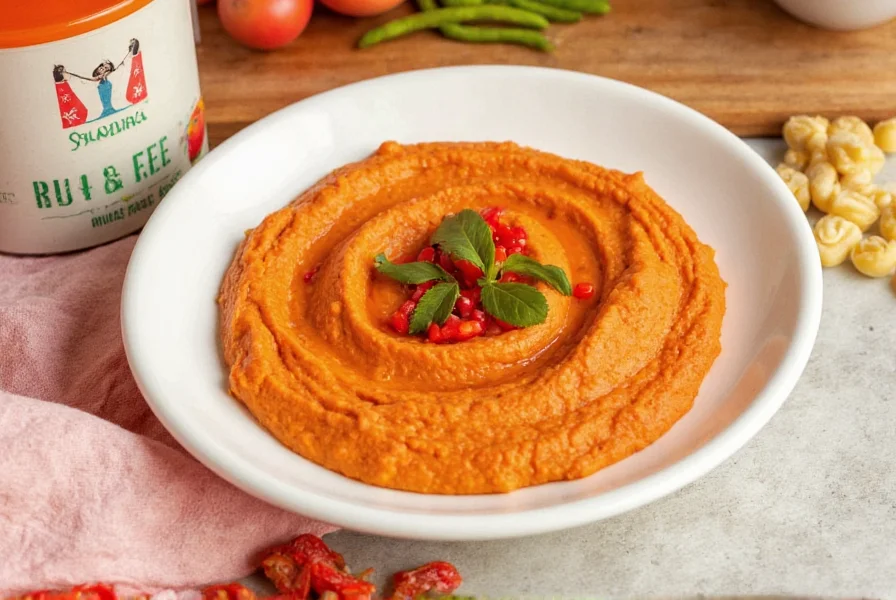Sabra Roasted Red Pepper Hummus has become a staple in many American households seeking convenient, flavorful plant-based options. This vibrant dip transforms the classic Middle Eastern spread by incorporating the natural sweetness of roasted red peppers, creating a distinctive flavor that appeals to both hummus enthusiasts and newcomers to this Mediterranean staple.
Understanding Sabra Roasted Red Pepper Hummus Composition
When examining sabra roasted red pepper hummus ingredients, you'll find a carefully balanced formula that maintains authenticity while introducing new flavor dimensions. The primary components include:
| Key Ingredient | Function | Contribution to Flavor Profile |
|---|---|---|
| Chickpeas | Base ingredient | Provides creamy texture and nutty foundation |
| Tahini (sesame paste) | Traditional hummus component | Adds richness and authentic Middle Eastern flavor |
| Roasted red peppers | Flavor differentiator | Imparts sweet, smoky notes that distinguish from plain hummus |
| Garlic | Seasoning | Provides aromatic depth without overpowering |
| Lemon juice | Acid component | Offers brightness and balances richness |
Nutritional Profile and Dietary Considerations
For those examining sabra roasted red pepper hummus nutrition facts, this product maintains the fundamental nutritional benefits of traditional hummus while adding the vitamins from roasted peppers. A standard 2-tablespoon serving typically contains:
- Approximately 70 calories
- 3g of plant-based protein
- 3g of dietary fiber
- Source of folate, iron, and vitamin B6
- Contains 2g of sugar (naturally occurring from peppers)
Unlike some flavored dips, Sabra Roasted Red Pepper Hummus remains naturally vegan and gluten-free, making it suitable for various dietary preferences. The roasting process enhances the natural sweetness of the peppers without requiring added sugars, distinguishing it from sabra roasted red pepper hummus vs regular hummus in terms of flavor complexity while maintaining similar nutritional properties.

Sensory Characteristics and Quality Indicators
The distinctive orange-red hue immediately identifies this variety from traditional beige hummus. When evaluating quality, look for:
- Consistent texture without separation
- Bright pepper aroma with subtle garlic notes
- Balanced flavor where neither pepper nor garlic dominates
- Creamy mouthfeel without graininess
Unlike poorly formulated flavored hummus products, authentic sabra roasted red pepper hummus maintains the smooth consistency expected of quality hummus while delivering the promised pepper flavor. The roasting process caramelizes the peppers' natural sugars, creating depth that artificial flavorings cannot replicate.
Practical Usage and Culinary Applications
While commonly used as a dip, this versatile product shines in numerous culinary applications. Consider these how to serve sabra roasted red pepper hummus suggestions:
- As a sandwich spread replacing mayonnaise for added flavor and nutrition
- Thinned with water or lemon juice as a salad dressing base
- As a pizza base instead of tomato sauce for Mediterranean-inspired creations
- Stuffed into chicken breasts or portobello mushrooms before baking
- Mixed with Greek yogurt for a flavorful vegetable dip
For those seeking sabra roasted red pepper hummus recipe ideas, try incorporating it into pasta dishes by tossing with warm noodles, roasted vegetables, and a splash of pasta water to create an instant sauce. It also works beautifully as a filling for deviled eggs or as a topping for baked potatoes.

Storage Recommendations and Shelf Life
Understanding proper storage is essential for maintaining quality. When addressing sabra roasted red pepper hummus shelf life considerations:
- Unopened containers remain fresh until the "best by" date printed on the package
- After opening, consume within 7 days when stored properly in the refrigerator
- Always use clean utensils to prevent contamination
- Store in the main compartment of the refrigerator, not the door where temperatures fluctuate
- Do not freeze as this alters the texture significantly
Separation of liquid (mainly water and oil) on the surface is normal and doesn't indicate spoilage. Simply stir gently before use to restore the original consistency. If you notice mold, unpleasant odors, or significant texture changes, discard the product regardless of the date.
Common Questions About Sabra Roasted Red Pepper Hummus
Is Sabra Roasted Red Pepper Hummus vegan?
Yes, Sabra Roasted Red Pepper Hummus is naturally vegan. It contains no animal products or byproducts, making it suitable for vegan diets. The ingredients consist of chickpeas, tahini, roasted red peppers, garlic, lemon juice, and other plant-based components.
How does roasted red pepper hummus differ from regular hummus?
Roasted red pepper hummus incorporates roasted red peppers into the traditional chickpea and tahini base, creating a slightly sweet, smoky flavor profile. This variation has a distinctive orange-red color and more complex taste compared to plain hummus, while maintaining similar nutritional properties and creamy texture.
Can Sabra Roasted Red Pepper Hummus be used in cooking?
Absolutely. Beyond serving as a dip, this hummus works well as a sandwich spread, pizza base, pasta sauce when thinned with water, or as a filling for proteins like chicken breasts. Its robust flavor enhances various dishes while adding creaminess and nutrition.
What are the primary nutritional benefits of Sabra Roasted Red Pepper Hummus?
This hummus provides plant-based protein, dietary fiber, and healthy fats from chickpeas and tahini. The roasted red peppers contribute vitamin C, vitamin A, and antioxidants. Each 2-tablespoon serving typically contains about 70 calories, 3g protein, and 3g fiber, making it a nutrient-dense option for snacks and meals.
How long does opened Sabra Roasted Red Pepper Hummus last in the refrigerator?
Once opened, Sabra Roasted Red Pepper Hummus should be consumed within 7 days when stored properly in the refrigerator. Keep it in its original container with the lid tightly sealed, and always use clean utensils to prevent contamination. Store in the main compartment of the refrigerator, not the door, for optimal temperature stability.











 浙公网安备
33010002000092号
浙公网安备
33010002000092号 浙B2-20120091-4
浙B2-20120091-4